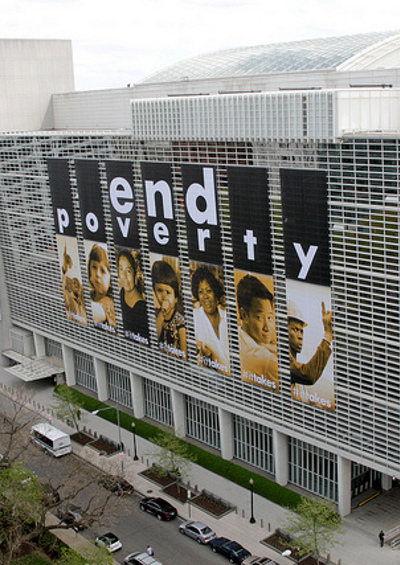The World Bank: The Data Gatherer That Did Not Gather Data
The World Bank subtly dodges debate about income inequality in rich countries.
July 23, 2014

Any good servant knows to steer clear of family fights. Why should this be less true of public servants?
So it is that the World Bank – which serves the countries of the world – appears to be avoiding one of the most hotly contested political economic issues in the rich countries: trends in income distribution. It is doing so not by misrepresenting information, but simply by failing to report it.
One might have expected the World Bank, which ably assembles and organizes so much economic and social data, to help shed light on the question of whether income distribution steadily is becoming more unequal.
After all, careful study of historical tax data bearing on this question has made an unlikely international superstar of a modest French economist, Thomas Piketty.
It may be somewhat surprising, therefore, to learn that World Bank data provided no more than a single observation of income distribution for any of the richest countries, from 1960 to 2013.
Handling the truth
The data in question are the shares of total income of various deciles and quintiles of the population. The World Bank compiled those data from the results of household survey data provided by member countries. As with other data series, the quality and quantity of income distribution data tend to improve as countries get richer.
If we line countries up by per capita income, the World Bank steadily provides more and more income distribution data as income rises. This is normal, as poorer countries generally have weaker data gathering capacity than richer countries and the World Bank relies on data provided by members.
The steady improvement in the availability of income distribution data works well – until it comes to an abrupt stop when income rises above about $20,000 (roughly the income level of Estonia).
In fact, the World Bank database contains not a single country with income higher than Slovenia’s ($26,000) with enough information to calculate a change in income shares (of course, a minimum of two observations are needed to look at changes).
Among the countries thus conveniently excluded from this potentially embarrassing exercise are Greece, New Zealand, Korea, Spain, Italy, Iceland, Japan, France, the UK, Ireland, Finland, Belgium, Australia, Germany, Bahrain, Canada…and so on (the total number of these richest countries is 35).
An odd silence
Mind you, it is not as though the World Bank’s standard operating procedure is to report only one year’s worth of income distribution data per country.
Indeed, for the 189 countries with per capita income data, there is an average of 4.6 observations of income distribution per country. That is, if you drew the name of one of these 189 countries at random, you could expect to find income distribution numbers for 4 or 5 years before 2013.
If and when those data points are available, you can then ask some questions. Is there evidence of a trend in income distribution? Has inequality been rising?
If the country you drew by chance turned out to be Brazil, you would find 26 years of income distribution data. For Poland, it is 19 years of data, for Thailand 14 and Turkey 11.
All told, of the 189 countries in the World Bank database, 107 have income distribution observations for at least two years, so at least one change in income shares can be observed.
All data, no observation
Applying the same percentage to the 35 richest countries, we would expect to find 20 of them with two or more years of data. However, such wealth obviously has its data-obscuring advantages. Not one of these richest 35 countries in the World Bank database has more than one year of data on income distribution.
Although there are countries at every income level that lack income distribution numbers, there is a definite pattern to the availability of data.
Between very low income (per capita income corrected for purchasing power) and income in the $15,000-$20,000 range, richer countries tend to have more observations of income distribution than poorer countries.
For example, countries with income of about $1,000 per year (Rwanda’s level) average about three years of numbers for income distribution (three observations).
Countries with income of about $10,000 (Jordan’s level) average about seven observations — and countries with income about $15,000 (Chile’s level) average nine observations of income distribution.
But then, above an income of about $20,000 (Estonia), income distribution data drop off sharply. After we have moved beyond Latin America’s and Eastern Europe’s income level, we are offered no more than one observation for income distribution for each of the richest OECD countries and no observations for small, resource rich countries.
Mum is the word
The figure below shows the moving average of the number of observations of income distribution per country for the 189 countries arranged by per capita income. To the right of the vertical blue line, there are no countries with more than a single observation.

What are we to make of this? It is not as though individual rich countries from which data are compiled lack income distribution numbers.
Indeed, the United Nations University offers an income distribution database with many observations for rich countries, including numbers from government sources.
Certainly, there are always good reasons to view data skeptically, but this is true of all countries and of virtually every data series collected and reported by the World Bank.
No, the availability of data is not the problem. I think that the failure of the World Bank to provide income distribution data that would inform the discussion of income distribution trends in the rich countries is simply a convenient way for the World Bank to avoid fueling controversy that could come back to burn it.
Researchers would use World Bank data to bolster claims about growing income inequality in many rich countries — and to advocate policies that bear not on poverty alleviation but on fairness. This is a policy debate the World Bank does not want to be associated with.
In short, what we are dealing with here is an implicit demonstration of who is upstairs and who downstairs in the world economy. Good servant that it is, the World Bank may inform on workers and tradesmen, but for the big guys upstairs, mum is the word.
Takeaways
When it comes to income inequality in rich countries and the World Bank, mum is the word.
1960 to 2013, World Bank data provide no more than a single observation of income distribution for rich countries.
Debate rages on income distribution in the developed world, but the World Bank does not want to weigh in.
The World Bank talks about inequality in the developing world, but keeps silent when it comes to rich countries.
The World Bank is so scared of the income inequality debate in rich countries that it will not report numbers on it.
The World Bank serves countries of the world. Is it trying to do so by staying silent on income inequality?
Read previous

The New (Dis)Order of the Middle East
July 22, 2014
